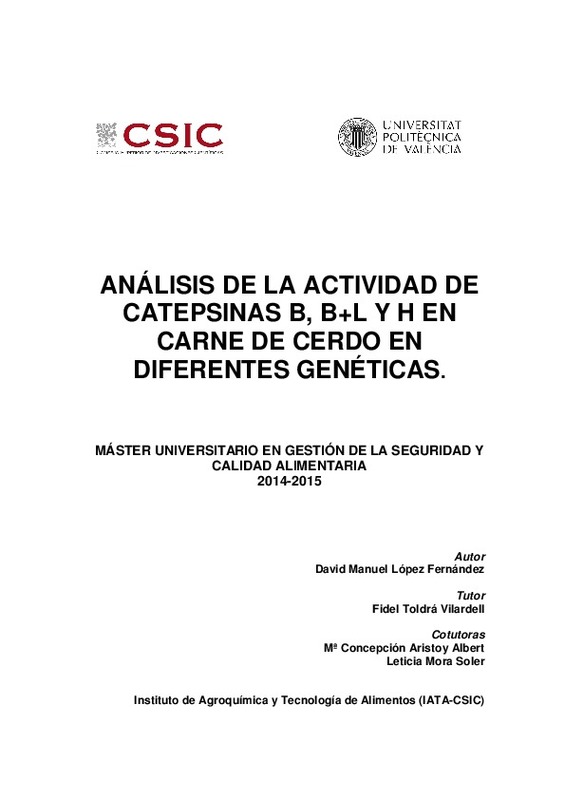|
Resumen:
|
[ES] Tras el sacrificio del animal, el músculo esquelético se convierte en carne por medio de la maduración ocurriendo una serie de reacciones bioquímicas esenciales para el desarrollo de la calidad, siendo la proteólisis ...[+]
[ES] Tras el sacrificio del animal, el músculo esquelético se convierte en carne por medio de la maduración ocurriendo una serie de reacciones bioquímicas esenciales para el desarrollo de la calidad, siendo la proteólisis uno de los grupos más importantes dentro de las reacciones bioquímicas en la carne. Éste es un proceso complejo en el que participan, entre otras, las catepsinas B, L y H dentro del grupo de las endopeptidasas. El objetivo del presente trabajo ha sido estudiar la influencia de la genética sobre la actividad de las catepsinas B, B+L y H en el músculo Longissimus dorsi de cerdos de un mismo lote, así como la influencia del momento de sacrificio en la actividad enzimática de animales pertenecientes a una misma genética. Para ello, se han estudiado cuatro genotipos diferentes, de los cuales, tres son genotipos industriales (IG) y uno de raza ibérica. La influencia de la genética en la actividad enzimática ha sido demostrada para los genotipos estudiados. Se observó mayor actividad de las catepsinas B+L en los cerdos IG mientras que la actividad de la catepsina H se mostró mayor en los cerdos ibéricos. Además, el momento de sacrificio influyó, observándose una mayor actividad enzimática en los cerdos sacrificados en el segundo lote respecto a los sacrificados en el primer lote. Finalmente, también se pretendió demostrar, mediante una cinética de reacción, la adecuación del método utilizado basado en la determinación de la fluorescencia.
[-]
[EN] After slaughtering, the skeletal muscle becomes meat through the ripening, occurring a number of biochemical reactions which are essential for the development of the meat quality, being proteolysis one of the most ...[+]
[EN] After slaughtering, the skeletal muscle becomes meat through the ripening, occurring a number of biochemical reactions which are essential for the development of the meat quality, being proteolysis one of the most important group into the biochemical reactions of the meat. This is a complex process that involves, among others, the cathepsins B, B+L and H inside the group of the endopeptidases. The purpose of this study was to study the influence of genetics on the cathepsins B, B+L and H activity in the Longissimus dorsi muscle in pigs from the same batch, as well as the influence of the slaughtering time in the enzymatic activity of pigs with the same genotype. In order to do this, four different genotypes were studied. Three of them were industrial genotypes (IG) and the other was an Iberian breed. The influence of the genetics in the enzyme activity was demonstrated in the genotypes studied. A higher activity of the cathepsin B+L was observed in IG pigs while the activity of the cathepsin H was higher in Iberian pigs. On the other hand, the time of sacrifice influences in the enzyme activity. The pigs slaughtered in the second batch had higher enzyme activity than those sacrificed in the first batch. Finally, it was also sought to demonstrate the adequacy of the method used based on fluorescence calculation by means of a reaction kinetics study.
[-]
|







